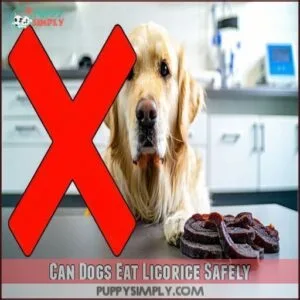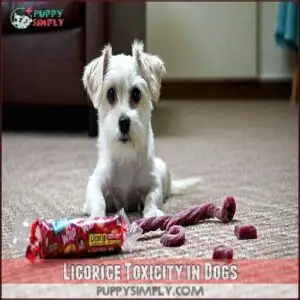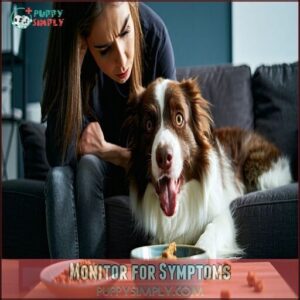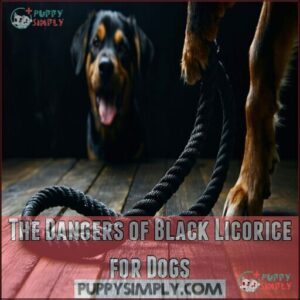This site is supported by our readers. We may earn a commission, at no cost to you, if you purchase through links.

This sweet treat could be a ticking time bomb for your furry friend. Licorice contains glycyrrhizin, a compound that can wreak havoc on your dog’s health, causing electrolyte imbalances, digestive distress, and potentially serious metabolic complications.
While those chewy black strands might look tempting to your pup, they’re packed with sugar and artificial ingredients that spell trouble.
One nibble could trigger a cascade of health issues, from increased thirst to potential long-term damage. Your dog’s safety is paramount, so keep licorice locked away and opt for vet-approved treats instead, ensuring your dog’s health is protected from serious metabolic complications.
Table Of Contents
- Key Takeaways
- Risks of Licorice Consumption in Dogs
- Can Dogs Eat Licorice Safely
- Immediate Effects of Licorice Consumption
- Long-term Effects of Licorice Consumption
- Licorice Toxicity in Dogs
- What to Do if Your Dog Eats Licorice
- Alternatives to Feeding Your Dog Licorice
- The Dangers of Black Licorice for Dogs
- How to Prevent Dogs From Eating Licorice
- Ensuring a Healthy Diet for Your Dog
- Frequently Asked Questions (FAQs)
- Is licorice good for dogs?
- Is licorice beneficial for diabetics?
- What happens if a dog eats licorice?
- Can dogs eat sugar-free licorice?
- Can dogs eat black licorice candy?
- Can dogs eat licorice & glycyrrhizin?
- Can dogs eat licorice root without Glycyrrhiza?
- Can dogs eat licorice wrappers?
- What happens if dogs eat licorice?
- Can dogs have twizzlers?
- Conclusion
Key Takeaways
- You can’t feed your dog licorice – it contains glycyrrhizin, a toxic compound that can disrupt your dog’s electrolyte balance and potentially cause severe health complications like muscle weakness and high blood pressure.
- Licorice‘s high sugar content and artificial ingredients pose serious risks to your dog’s health, including potential obesity, dental issues, pancreatitis, and diabetes.
- If your dog accidentally consumes licorice, you’ll need to monitor for symptoms like vomiting, excessive thirst, muscle tremors, and behavioral changes, and contact your veterinarian immediately.
- Instead of licorice, opt for safe, dog-friendly treats like natural apple or pumpkin snacks that provide nutrition without the dangerous side effects, ensuring your furry friend stays healthy and happy.
Risks of Licorice Consumption in Dogs
If you’re tempted to share your favorite licorice candy with your furry friend, think twice about the potential health hazards lurking in those sweet treats.
Your dog’s well-being could be at serious risk from seemingly innocent ingredients like glycyrrhizin, high sugar content, and toxic artificial additives that can trigger a range of dangerous health complications, including risks to their health.
Beware the sweet deception: One licorice treat could unleash a storm of canine health dangers.
Toxic Ingredients
Ever wondered why your furry friend should steer clear of licorice? Toxic ingredients lurk within these seemingly innocent treats, posing serious health risks to dogs.
Here’s what you need to know:
- Xylitol Toxicity: This artificial sweetener can trigger life-threatening reactions in dogs, potentially causing rapid insulin release and liver failure.
- Glycyrrhizin Dangers: A natural compound that disrupts your dog’s electrolyte balance and can lead to serious health complications.
- Artificial Sweeteners: Hidden chemical cocktails that spell trouble for your canine companion.
- Preservative Risks: Artificial colors and flavors may trigger unexpected health issues in sensitive dogs.
Glycyrrhizin Effects
Dive deep into the hidden dangers of glycyrrhizin for your furry friend.
This potent compound in licorice wreaks havoc on your dog’s health, triggering dangerous glycyrrhizin toxicity.
Beware the hidden danger: Glycyrrhizin transforms sweet treats into a toxic threat for your furry friend.
It disrupts electrolyte balance, causing alarming shifts in potassium levels and potentially spiking blood pressure.
Dogs consuming glycyrrhizin risk muscle weakness, heart complications, and severe metabolic disturbances that can rapidly escalate from manageable to life-threatening.
High Sugar Content
Behind the sweet facade of licorice lies a treacherous sugar trap for your furry friend.
High sugar intake can trigger a cascade of health consequences, from rapid weight gain to diabetes risks.
Your dog’s delicate metabolic balance hangs in the balance, with each sugary bite potentially leading to nutrient imbalance and long-term dietary dangers.
Consuming sugary treats can lead to sugar toxicity risks that are harmful to dogs, posing a significant health risk.
Artificial Flavors and Colors
After loading up on sugar, artificial flavors and colors in licorice can turn a harmless snack into a canine health hazard:
- Synthetic dyes trigger allergic reactions
- Chemical flavor enhancers disrupt metabolism
- Food additives cause digestive stress
- Color toxicity impacts neurological function
- Toxic ingredients like xylitol lead to severe complications
Your furry friend’s health hangs in the balance with every colorful, artificially flavored bite, due to the presence of artificial flavors.
Can Dogs Eat Licorice Safely
As a pet owner, your dog’s health hinges on understanding hidden dietary dangers like licorice.
Can dogs safely enjoy this sweet treat? Absolutely not.
- Licorice harbors serious toxic risks
- Xylitol threatens canine well-being
- Veterinary guidance is essential
- Safe alternatives exist
Consuming licorice can trigger severe health complications for your furry friend.
While the candy might seem harmless, its ingredients pose significant threats to dog nutrition and pet safety.
Always prioritize your dog’s health by avoiding potentially harmful foods and consulting with a professional about safe, nutritious alternatives.
Immediate Effects of Licorice Consumption
When your dog consumes licorice, you’ll want to be prepared for a range of immediate health complications that can strike quickly and unexpectedly.
From electrolyte disruptions to digestive distress, the consequences of licorice ingestion can transform a seemingly innocent treat into a potential veterinary emergency.
Electrolyte Imbalance
When your dog nibbles licorice, you’re risking a dangerous electrolyte shift.
The glycyrrhizin compound wreaks havoc on mineral balances, causing sodium retention and potassium loss.
These ionic disturbances can trigger muscle weakness, tremors, and potential hyperaldosteronism.
Watch for signs of electrolyte imbalances that could quickly transform a sweet treat into a serious health threat.
Digestive Issues
When electrolyte imbalances strike, your furry friend’s digestive system can spiral into chaos.
Licorice triggers a storm of stomach problems that’ll make their gut cry uncle.
Watch for these warning signs:
- Violent stomach cramps
- Explosive diarrhea
- Persistent nausea
- Spontaneous vomiting
Glycyrrhizin toxicity transforms a simple treat into a digestive nightmare, wreaking havoc on your pup’s delicate internal ecosystem, causing chaos.
Behavioral Changes
After your furry friend chomps down on licorice, watch for red flags in their behavior.
Anxiety signs and mood swings can signal licorice toxicity, with dogs displaying unexpected aggression or sudden lethargy.
Hyperactivity triggers might alternate with muscle cramping, painting a concerning picture of dog licorice poisoning that demands immediate veterinary attention.
Increased Thirst and Urination
When licorice strikes, your canine companion might start gulping water like there’s no tomorrow. Increased thirst becomes a red flag signaling potential kidney strain and electrolyte imbalance.
- Water rushing through their system
- Frequent bathroom breaks
- Urine output skyrocketing
- Kidneys working overtime
Watch closely for these dog licorice poisoning symptoms, as glycyrrhizin toxicity can quickly turn a sweet treat into a dangerous health challenge.
Long-term Effects of Licorice Consumption
If you’ve been casually tossing licorice treats to your furry friend, you might be unknowingly setting the stage for a cascade of serious health complications.
Your dog’s seemingly innocent indulgence could trigger long-term metabolic disruptions, potentially leading to conditions like hyperaldosteronism, obesity, dental deterioration, and increased risks of pancreatitis and diabetes.
Hyperaldosteronism
Your pup’s love for licorice might trigger a serious hormone havoc known as hyperaldosteronism. This condition wreaks silent havoc on your dog’s adrenal glands, causing an aldosterone overdrive that disrupts their delicate hormone balance.
| Warning Sign | Body’s Message | Smart Action |
|---|---|---|
| Excessive Thirst | Kidney Distress | Consult Vet |
| Muscle Weakness | Hormone Imbalance | Monitor Closely |
| Frequent Urination | Electrolyte Shift | Track Symptoms |
Glycyrrhizin, the sneaky compound in licorice, mimics Addison’s disease symptoms by throwing potassium levels into chaos. Your furry friend’s kidney function could take a serious hit, leading to pseudohyperaldosteronism that throws their entire system off-kilter. Watch closely and stay alert to these warning signs. Kidney distress and hormone imbalance are critical indicators that require immediate attention, and it’s essential to consult a vet if you notice any unusual behavior.
Obesity and Dental Issues
Every sweet temptation can be a ticking time bomb for your dog’s health.
Sugary licorice isn’t just a treat—it’s a gateway to serious dental and weight problems:
- Sticky sugars erode tooth enamel faster than you’d imagine
- Cavities become silent destroyers of canine dental health
- Excess weight creeps up, turning your active companion into a sedentary shadow
Protect your furry friend’s nutrition and well-being.
Pancreatitis and Diabetes Risks
One small slip-up can send your dog’s pancreas into overdrive, potentially triggering a cascade of health complications.
Licorice consumption risks severe consequences:
- Blood Sugar Disruption: Insulin resistance escalates
- Pancreas Damage: Inflammatory responses intensify
- Long-term Health Risks: Diabetes development accelerates
Monitoring your dog’s diet closely prevents these dangerous dietary triggers, safeguarding against licorice toxicity and potential metabolic disasters, which can be considered a long-term health risk.
Licorice Toxicity in Dogs
If you’re a dog owner wondering about licorice, be warned: this sweet treat can pose serious health risks to your furry friend.
The glycyrrhizin compound and high sugar content in licorice can trigger dangerous toxicity symptoms, potentially leading to severe complications that could harm your pet’s well-being.
Glycyrrhizin Poisoning
Your dog’s well-being hangs in the balance when glycyrrhizin strikes.
This toxic compound can trigger dangerous glycyrrhizin toxicity, causing potassium depletion and muscle weakness in dogs.
Symptoms like high blood pressure and heart rhythm disruptions signal serious licorice dog poisoning risks.
Watch closely and contact your veterinarian immediately if you suspect glycyrrhizin consumption.
Sugar Toxicity
In the face of licorice’s sweet temptation, sugar toxicity lurks as a silent threat to your furry friend.
Packed with harmful sugars and potentially deadly xylitol, these treats can trigger a cascade of health risks, from rapid weight gain to full-blown diabetes.
Sugar addiction in dogs isn’t just a quirky habit—it’s a serious health hazard that demands your vigilance.
Licorice Poisoning Symptoms
When sugar’s sweet spell turns sour, watch for these alarming licorice toxicity symptoms in your furry friend:
- Sudden, explosive vomiting
- Trembling muscles and weakness
- Rapid breathing and restlessness
- Unquenchable thirst signaling electrolyte chaos
Glycyrrhizin’s toxic grip can trigger serious dog licorice poisoning. Your pup’s health hangs in the balance – if these warning signs emerge, rush to the vet immediately to prevent potential life-threatening complications.
What to Do if Your Dog Eats Licorice
If your dog has nibbled on licorice, don’t panic, but act quickly and attentively.
Monitor your pet closely for symptoms like vomiting, increased thirst, or lethargy, and contact your veterinarian immediately to guarantee your furry friend’s safety.
Contact a Veterinarian
In the critical moments of dog licorice poisoning, your veterinary lifeline becomes your most important resource.
Immediately contact your local emergency animal hospital or pet poison hotline for expert veterinary advice. Have your dog’s medical records and insurance information ready.
Quick action can prevent serious complications and potentially save your furry friend’s life. Recognizing common pet issues, such as pet health problems, is essential for providing proper care and attention to your dog’s overall well-being.
Monitor for Symptoms
After consulting your vet, become a canine health detective. Watch closely for telltale signs of licorice toxicity that could spell trouble for your furry friend.
- Vomiting and diarrhea
- Unusual lethargy
- Muscle weakness
- Excessive thirst
Your pup’s body might be sending out distress signals after glycyrrhizin exposure. Carefully document any abnormal behaviors or symptoms. These observations could be critical in helping your veterinarian understand the potential health risks and determine the best course of treatment for your four-legged companion, which is a critical step in ensuring their well-being.
Seek Immediate Care if Necessary
Your dog’s licorice emergency demands swift action. Call your Emergency Vet or Poison Control immediately if your pup shows signs of licorice toxicity.
Don’t induce vomiting without professional guidance. Watch for symptoms like tremors, weakness, or behavioral changes.
Time is critical in dog poisoning cases, so prioritize urgent medical attention to prevent potential long-term health complications.
Alternatives to Feeding Your Dog Licorice
If you’re searching for safe and nutritious alternatives to licorice for your furry friend, stop your search here than natural dog treats that’ll keep your pup happy and healthy.
Instead of risking your dog’s well-being with potentially harmful licorice, opt for wholesome options like organic apple or pumpkin treats that provide both flavor and nutrition.
1. All Natural Apple Dog Treats
After discovering the dangers of licorice, you’ll want a safe treat your pup will love.
Wholesome Pride’s all-natural apple treats are a game-changer for dog nutrition:
- 100% pure dehydrated apples
- Packed with pet wellness benefits
- Zero artificial ingredients
- USA-made with love
These healthy snacks offer a tasty alternative that keeps your furry friend safe from licorice toxicity.
2. Organic Pumpkin Dog Cat Treats
Want a tail-wagging snack that’ll keep your furry friend healthy? Organic Pumpkin Dog Cat Treats are your golden ticket!
Packed with Pet Nutrition and bursting with Pumpkin Benefits, these grain-free morsels support digestive wellness.
Forget risky licorice—these treats offer a safe, nutrient-rich alternative that’ll have your pup begging for more while boosting Dog Wellness.
The Dangers of Black Licorice for Dogs
If you thought black licorice was just a harmless snack, think again. Black licorice can be a ticking time bomb for your furry friend’s health. In the context of canine toxicity, this seemingly innocent treat packs a serious punch.
Here’s why black licorice is a no-go for dogs:
- Glycyrrhizin effects can trigger dangerous blood pressure fluctuations
- Toxic compounds rapidly disrupt your dog’s delicate internal balance
- Licorice toxicity symptoms can escalate from mild discomfort to life-threatening conditions
The glycyrrhizin in black licorice wreaks havoc on your dog’s system, potentially causing muscle tremors, seizures, and severe electrolyte imbalances. Xylitol and high sugar content only compound the risks, turning this sweet treat into a potential health nightmare.
Veterinary experts unanimously agree: keep black licorice far away from your four-legged companions. Your dog’s well-being depends on your vigilance.
How to Prevent Dogs From Eating Licorice
Your dog’s insatiable curiosity can turn a sweet treat into a dangerous health hazard, especially regarding licorice.
Protect your furry friend by implementing strategic prevention methods that secure potentially toxic candies and train your pet to resist tempting but harmful snacks.
Training Dogs to Avoid Licorice
Training your four-legged friend to dodge licorice requires strategic pet safety measures. Focus on mastering key commands that protect canine health.
- Teach the rock-solid "leave it" command
- Use high-value treats as positive reinforcement
- Create consistent training routines
Effective dog training often relies on proper training equipment tools. By implementing these dog training tips, you’ll safeguard your pet from potentially dangerous licorice consumption while strengthening your bond.
Securing Licorice and Other Sweets
Keep licorice and sweets out of your dog’s reach with strategic pet proofing. Use child locks on cabinets, store treats in high, secure locations, and invest in dog-proof containers.
Protect your pup from toxic temptations by creating barriers that prevent accidental ingestion. Separate human snacks from dog treats, prioritizing your furry friend’s safety with smart storage solutions.
By understanding the dangers of toxic ingredients, you can better safeguard your dog against harmful substances.
Storing Sweets in Upper Cabinets
High shelves become your first line of defense against dog candy consumption.
Strategically place sweet storage out of your furry friend’s reach, using upper cabinet security to prevent toxic temptations. Shelf organization isn’t just about tidiness—it’s a critical shield protecting your dog from licorice and other dogfriendly foods that could spell serious health risks.
Effective cabinet lock systems can provide an additional layer of protection for your dog, ensuring cabinet security and upper cabinet safety are maintained.
Using Child-Proof Containers
After securing upper shelves, seal the deal with childproof containers designed to block curious canine noses from toxic treats.
These lockable guardians prevent dog licorice consumption with fortress-like protection.
- Install containers with robust latches
- Choose containers with complex opening mechanisms
- Place containers in high, unreachable spots
- Select models with multiple locking points
- Opt for containers with transparent warning labels
Your pet’s safety starts with smart, strategic storage.
Ensuring a Healthy Diet for Your Dog
You’re the guardian of your dog’s health, and understanding their dietary needs is vital for their well-being.
Regarding treats like licorice, knowing the potential risks and making informed choices that keep your furry friend safe and healthy is paramount.
Consult With a Veterinarian
A wise guardian knows that regarding your dog’s health, a veterinarian is your most trusted ally.
Before diving into licorice risks, schedule a thorough consultation to safeguard your furry friend’s well-being:
- Review personalized medication and dosage guidelines
- Establish emergency protocols for potential licorice exposure
- Discuss breed-specific health vulnerabilities
- Evaluate pre-existing conditions and related risks
Regular veterinary care is vital for maintaining high-quality dog health checks to prevent potential issues, ensuring your dog receives the best possible health checks and care for a long and healthy life with proper emergency protocols.
Choose Dog Treats Formulated For
Your veterinarian’s guidance sets the stage for selecting the perfect dog treats. When browsing the pet food aisle, focus on treats formulated to your dog’s unique nutritional needs—whether targeting dental health, joint support, or managing sensitive stomachs.
Scrutinize labels for clear, simple ingredients that support canine diet and pet safety. Prioritize natural treats free from artificial preservatives and xylitol. Look for specialized formulations addressing weight management or skin allergies.
Remember, dog nutrition isn’t one-size-fits-all—choose wisely to keep your furry friend healthy and happy. Considering the right dog treat options is vital for a balanced diet.
Healthy Snack Options for Dogs
After steering clear of licorice’s risky treats, let’s explore delicious alternatives that’ll make your pup’s tail wag with joy! Your dog’s diet deserves nutritious options that tantalize taste buds while supporting overall wellness.
- Crisp carrot sticks dancing with natural sweetness
- Blueberry-studded yogurt offering probiotic punch
- Tender sweet potato chunks bursting with vitamins
- Crunchy green beans providing fiber-packed satisfaction
When selecting snacks, focus on whole foods that nourish without unnecessary risks. Mix homemade treats with high-quality commercial dog snacks to create a balanced canine diet. Remember, every bite counts for your furry friend’s long-term health and happiness.
Frequently Asked Questions (FAQs)
Is licorice good for dogs?
Licorice isn’t safe for your dog.
It can cause serious health risks like electrolyte imbalances, high blood pressure, and potential kidney damage.
Always consult your vet before introducing any new treats to your pet’s diet, especially since licorice can have severe consequences.
Is licorice beneficial for diabetics?
You’ll want to approach licorice cautiously if you’re diabetic.
Its glycyrrhizin can potentially affect blood sugar levels and interact with diabetes medications.
Always consult your healthcare provider before incorporating licorice into your diet.
What happens if a dog eats licorice?
When a sugary storm strikes your pup’s system, licorice can trigger a cascade of health havoc.
From electrolyte chaos to potential seizures, risking dangerous blood pressure spikes, and triggering serious symptoms requiring immediate veterinary intervention.
Can dogs eat sugar-free licorice?
You’ll want to steer clear of sugar-free licorice.
It often contains xylitol, a toxic sweetener that can cause seizures, liver failure, and dangerous drops in blood sugar for your furry friend.
Can dogs eat black licorice candy?
Like a siren’s tempting call, black licorice candy isn’t safe for your furry friend.
It contains harmful glycyrrhizin and sugar that can trigger serious health risks, potentially causing seizures, electrolyte imbalances, and dangerous blood pressure fluctuations.
Can dogs eat licorice & glycyrrhizin?
You’ll want to steer clear of glycyrrhizin for your furry friend.
While small amounts might seem harmless, it can trigger serious health risks like blood pressure spikes, electrolyte imbalances, and potential organ complications in dogs.
Can dogs eat licorice root without Glycyrrhiza?
Back in the day of horse-drawn carriages, veterinarians caution you about licorice root without glycyrrhizin.
While technically less risky, you’ll still need professional advice, as individual dog sensitivities vary and potential health complications remain possible, due to the presence of glycyrrhizin.
Can dogs eat licorice wrappers?
Don’t let your pup near licorice wrappers! They’re choking hazards that can cause intestinal blockages.
Sharp edges might puncture delicate digestive tracts, risking serious medical emergencies that’ll send you racing to the veterinarian.
What happens if dogs eat licorice?
If dogs consume licorice, they might experience serious health risks like electrolyte imbalances, blood pressure spikes, and potential poisoning symptoms.
Including vomiting, diarrhea, muscle weakness, and in extreme cases, seizures or kidney problems.
Can dogs have twizzlers?
You shouldn’t feed Twizzlers to your furry friend.
These sugary treats contain harmful ingredients like corn syrup, artificial sweeteners, and potential xylitol, which can cause serious health risks for dogs.
Including digestive issues and toxicity.
Conclusion
When Max, a Labrador, accidentally nibbled black licorice at a family picnic, his owners rushed him to the vet, narrowly avoiding serious complications.
Understanding "can dogs eat licorice" is essential for pet safety.
Your vigilance matters most—stay informed about toxic treats, prioritize veterinarian-approved snacks, and always err on the side of caution.
By educating yourself and monitoring your dog’s diet, you’ll protect them from potential health risks associated with seemingly harmless human foods.
- https://en.wikipedia.org/wiki/Glycyrrhizin
- https://www.hersheyland.com/twizzlers
- https://www.mayoclinic.org/diseases-conditions/addisons-disease/symptoms-causes/syc-20350293
- https://www.sciencedirect.com/topics/agricultural-and-biological-sciences/glycyrrhizin
- https://www.cspinet.org/sites/default/files/media/documents/resource/food-dyes-rainbow-of-risks.pdf




















